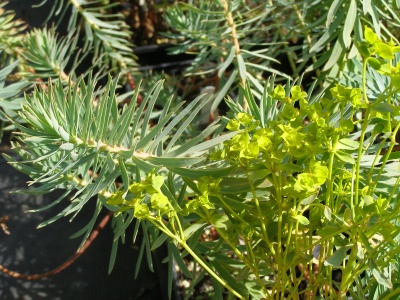All Products
The flowers are pale yellow to green in 80cm long spikes, with a distinct pineapple-like ruff of leaves on the top. Huge rosettes of broad green leaves with distinctively serrated edges. To 150cm tall. Late flowering and has proved hardy with us, but plant deeply.
Many heads of yellow flowers. Makes wide-spreading mounds of many narrow blue-green leaves. Pinkish stems. Well-drained soil in sun. 30cm. June/July. A hybrid of E. nicaeensis and seguireana discovered by Tim Ingram.
Rich golden-yellow heads of flowers to 20cm across. Narrow, pale green leaves to 8cm long with paler midribs on beautiful, wiry, pinky-orange stems. To 1m high and 2m across. An established plant will flower a full 12 months of the year. Very dry, in full sun. Can be cut back by a hard winter but very rarely killed. Collected by John Raven in the 1970s in Sicily.
A very beautiful diminutive herbaceous plant with bright blue, yellow-centred flowers and dark green, daisy-like basal leaves. Very hardy to minus 14C. 15cm. Damper soils soil in sun. May/June.
Yellow flowers in abundance typical of a F. x intermedia. The leaves, however, are strongly margined in pure white especially in early spring. The margins thin and the centres become more green as the season goes on. Very beautiful and unaccountably rare. Shrub to 2m. March. Any soil but better in part shade. Surprisingly vigorous. To us from Ollie Neave.
A distinct and stunning hybrid snowdrop which is very upright and a good vigorous doer! The markings in the flower are solid dark green at the tip of the inner petal becoming slightly diffuse towards the base. The inner petals are distinctive in that they do not flare at the tips, producing a very tubular-looking flower. This plant gained an RHS preliminary commendation in 2006. It was found by me in a garden in Herefordshire formerly owned by the Backhouse family (famous for daffodils). It was named for the wife of the current owner.
A short-growing and relatively late hybrid with the distinct feature of incredibly thick petals. This makes it really difficult to open up to see the mark inside. Raised by Wiliam Thomson before 1913, possibly named by S. Arnott.
Large flowers, often two per bulb. Narrow blue-grey leaves. A complex hybrid possibly involving GG. gracilis and plicatus. From Kingston Bagpuize.
‘Bertha’ a pterugiform with a very distinctive mark on the inner like an H or a pinafore. Small but very vigorous. Named for my current dog, Bertha or Bert for short
Large, well-shaped flowers produced earlier than others in the group. The large apical mark diffuses slightly down the petal. Blue-green arching leaves. A robust stout hybrid from the mighty atom group.
Many fully double flowers with narrow outers exposing the inners which are heavily marked green. The first G. elwesii hybrid double with green-tipped outers. Later than 'Franz Josef' but still relatively early. Increases well. Found by Robert Marshall.
Another in the mighty atom group with truly massive flowers when settled in. Relatively early flowering but later than 'Bertram Anderson'. Short blue-green leaves. Found by, and named for Bill Bishop.
a large vigorous hybrid, a bit like ‘Ketton’ but larger and more elegant.
This is a superb green tipped snowdrop. It was first noticed in 1987 by Michael Heard in the Bakers’ garden and named for David Baker in 1997. In the meantime it had been known as ‘the green tipped Atkinsii’, with which it shares many similarities. The green mark comes and goes from year to year with about half to two thirds of the flowers marked in any year.
A neat, dark, single mark marking a broad, shallow V. Huge flowers. A strong, very robust and vigorous snowdrop in the mighty atom group. Named for a former residence of Herbert Ransom, gardener to the Mathias family of Giant Snowdrop Company fame.
This is a superb new green-tipped, hybrid double with two marks on the inner. It is early flowering and is upright with narrow leaves. The markings on this snowdrop varies from year to year and no two flowers are the same. Earlier and taller than 'Betty Hansell'. It was discovered recently in Germany.
This tall, mid to late season snowdrop is quite big and stout and reliably has two flowers per bulb. The inner is almost entirely green. It is a cross between G. elwesii and G. plicatus with intermediate leaves. It was found in the park at Colesbourne and was named for the son of the Elwes family who tragically died.






.jpg)